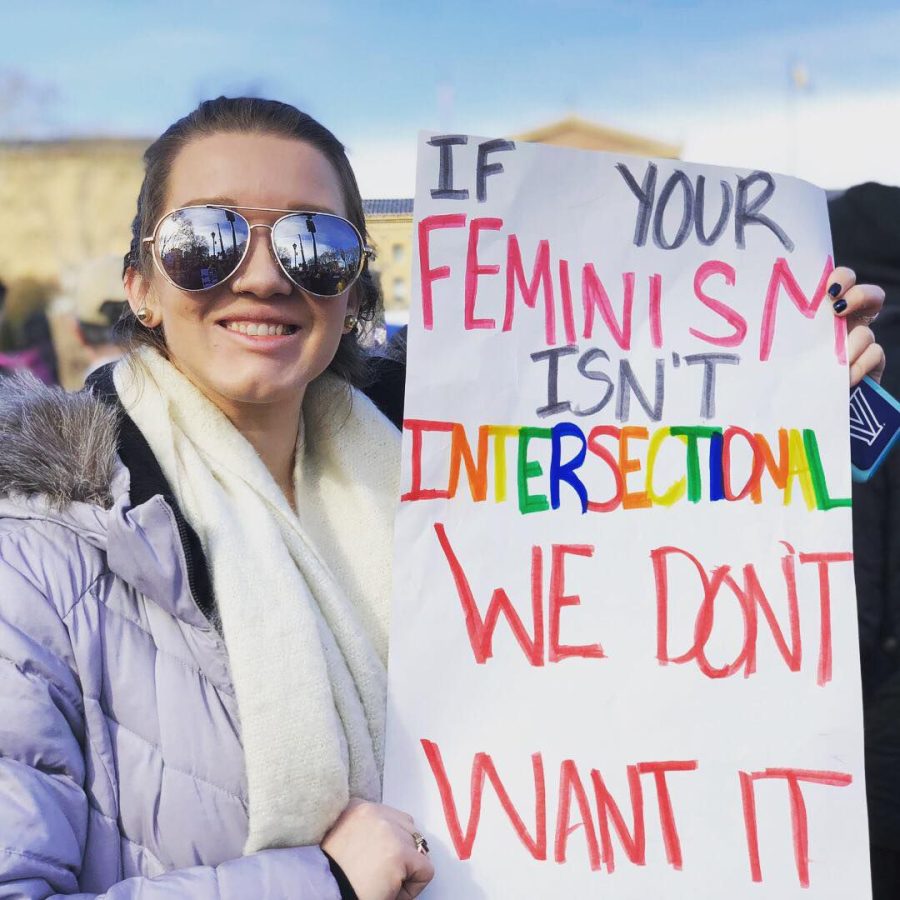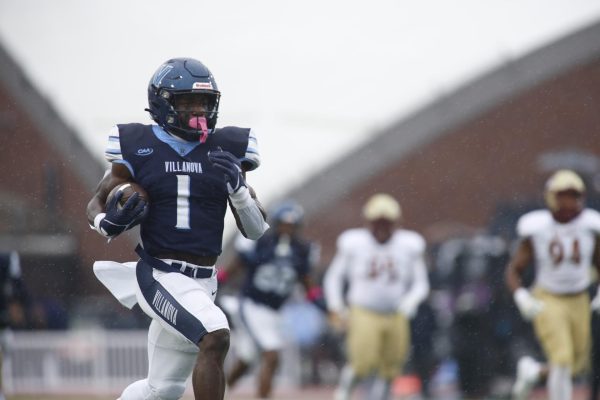Villanova Students Champion Women’s Rights in Annual March
January 30, 2018
Last weekend, city streets around the world were flooded by participants in the second annual Women’s March. More than 200,000 protestors attended the event in New York, with another 300,000 in Chicago and a massive 600,000 taking to the boulevards of Los Angeles. In Philadelphia, the number surpassed last year’s 50,000 and closed down the Parkway along a route that stretched around Race and Vine streets. The march’s motto of “We Resist. We Persist. We Rise” reflects the efforts of Americans to bring attention to centuries of systemic injustice against women.
Protestors in Philadelphia woke up early, gathering in Logan Square as early as eight in the morning. From there, they marched towards Eakins Oval, where a rally with speakers and performers kicked off at noon. Among the sea of pussy-cat ears and punny signs, Villanova students brushed shoulders with a squad of protestors including men, women, members of the LGBT and minority communities. According to Lauren Munter, a Villanova junior from Elkridge, Maryland, the majority of the participants were young. If anything, however, this demographic imbalance added to the energy of the event.
“I would say that it’s definitely a positive experience in the sense that there is this overwhelming air of hope,” Munter, the aspiring nurse said. Elaborating, she describes a “hope that, regardless of all the less-than-stellar things that we see in the headlines, there are people who believe in and are trying to actually take action in a way that will improve things.”
The headlines Munter described have been numerous and alarming, and the persons they indict range from radio DJs to movie producers to the President of the United States. Charges of harassment and assault have escalated over the past few years, and many view the Harvey Weinstein scandal as the catalyst. When it broke on Oct. 5, 2017, the New York Times story detailing years of accusations against the film mogul triggered the metaphorical opening of the floodgates. Hundreds of women from around the country have come forward regarding their own experiences of sexual harassment, with TIME magazine selecting “The Silence Breakers” as its Person of the Year.
Amidst such a climate, the second Women’s March has taken on even greater importance. While the first was organized as a response to the election of Donald Trump—a man whose derogatory statements are now etched indelibly into the American mind—the 2018 gathering celebrates women’s growing unity. In Munter’s opinion, marching serves a key purpose in the world of social activism. “[The action demonstrates] visibility of the opinions of the population, Munter said. “As many people as show up to these marches, there is always a silent, invisible group who aren’t as willing to be as [present]. Marching shows the representatives and the lawmakers and the laypeople that [we] are not happy, that there needs to be change.”
The sea of faces that flooded city streets last weekend offers a physical manifestation of a mentality. It quantifies a problem, drawing attention to the magnitude of the challenges facing women and literally embodying the issue.
To Munter, one of those issues lies in a fundamental misunderstanding of feminist movements.
“People try to equate feminism with misandry (hatred of the male sex),” she said. “That’s not the sense at all. It’s the belief in total equality of the sexes.” She offered up an interpretation of the indignation or resentment that some men express when confronted with the term. “I feel like when people take offense, that is them thinking their privilege is being called into question,” she said. “When you have privilege, equality feels like an attack, and that’s not the case.”
Like it or not, the movement is here to stay, and it’s important that even non-participants find a way to interact with the concepts presented. “Just listening is the first step,” Munter said. “I think a lot of the times someone says feminism, and then a switch turns off, like here we go again. You have no progress if you don’t listen.”
Saturday’s march was all about expression. Protestors used clever signs to voice their concerns and grab the attention of observers. “I saw a couple Black Lives Matter signs,” Munter, along with many, said “’If it’s not intersectional, it’s not feminism signs.’ “A lot of them were more. . . I don’t want to say comical, but there was an air to sarcasm and satire, which I think is a good tool.”
The diversity of the marchers drew attention to certain complexities regarding feminist issues. “I personally view feminism as very intersectional. I think a lot of people hear women’s march and think pro-choice, women’s health, birth control, and that is part of it,” she said. “I also think that some of it is marching for immigrants, refugees, black lives matter, all these other issues, because you can’t only stick up for one kind [continued from pg. 7] of woman.”
Munter and her friends were among those brandishing written messages, which they had crafted in their apartment the night before. Among those friends was senior Maddy Lancaster, a Finance major from New Hampshire for whom the 2018 event was her first. “Overall, the experience was incredibly empowering,” Lancaster said. “I was surrounded by strong women of all ages, races and sizes, who were marching for women’s rights. It made me feel like I was important—part of something.” Munter was equally enthusiastic, although her existing experience marching led to inevitable year-over-year comparisons. “I think last year was definitely more of a big deal. Last year I made a bigger sign, double-sided.”
Critical to the march’s success is consideration of desired outcomes. What form does the ideal for which women like Munter, Lancaster and fellow marchers are striving, take? For female students at Villanova, the most immediate transformation would happen on their college campus. Although their experiences with men at Villanova have been positive overall, both Munter and Lancaster identify areas for improvement.
“I do think that there is a little bit of gender segregation,” Munter said .“I don’t want to use the [term] ‘locker room talk’ because I think it’s [nonsense], but I think men talk about women in a way that’s not the most respectful.”
Lancaster voices a similar opinion; “I think our campus tries very hard to be respectful of women, and emphasize empowerment, but the issue of equality is simmering under the surface. I don’t blame Nova, but inequality is deeply ingrained in our society, and it’s going to take a lot more than University propaganda to fix it.”
Munter describes derogatory conversations as taking place mainly behind closed doors, a situation that could be interpreted in a variety of ways. On the one hand, it’s frustrating to think that women are still being objectified in any way. On the other, this restraint indicates an understanding by men on campus of the respect deserved by their female counterparts.
“I think it’s a step in the right direction, because I think recognizing you have a problem is the first step to recovery,” says Munter. “If these guys are cognizant of the fact that their mindset is wrong, to the point where they’re not broadcasting it, it shows they have a conscience.”
Villanova men should be gratified to hear that their care is not going unnoticed. Yet any appreciable change—as has been evidenced by years of American history—takes time. This is particularly true of change within the government system. Policy lag is a real threat to progress, as societal consensus regarding pressing issues is often met long before the enforcing legislature gets drafted. If granted the ability to pass one official measure instantaneously and without opposition, Lancaster knows immediately how she’d exert her power: “I would permanently establish Michelle Obama as president.”
After having voiced such an aspirational idea, Lancaster does opt for a more conservative option as well. She would increase government funding of Planned Parenthood, along with establishing a floor for those funds that would provide consistent flow of income to the organization.
“I wish I knew more about politics,” she said.
Lancaster, however, should be proud of what she does know. As was remarked earlier, for every audible voice there is one laboring in silence. Villanova students’ efforts to involve themselves is inspiring—the women interviewed for this story were only two of hundreds that made the journey from campus to the city on Saturday. As the fate of America advances, more history will be made by these courageous and determined individuals. The legacy they leave behind is one of which the Villanova community should be deeply proud.
The great part about activism is its open enrollment. We can choose at any time to involve ourselves, in as little or as great a manner as we desire. Advocacy takes many forms: calling senators, joining grass roots organizations, distributing informational material or just starting pertinent conversations. The Women’s March was but one way of expressing an opinion, and Munter, personally, would give it a positive review. “I would [go],” she says. “Even if you don’t necessarily agree with what the women’s march is trying to promote, it was a positive environment and there is a lot to learn from other women that you may encounter.”
For Lancaster, marching takes on a similar import to the one described by Munter—a public display of discontent. “Do I personally think that my voice will make a huge difference?” she asks rhetorically. “No. But when combined with the voices of thousands of other women? That’s the start of a revolution. Mic drop.”











